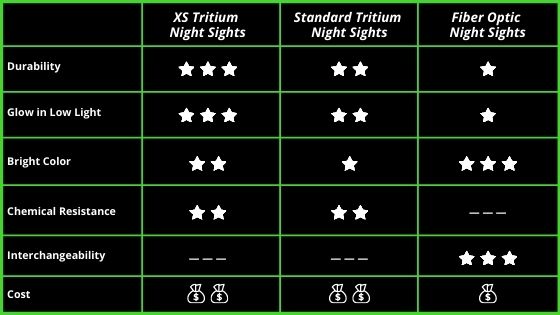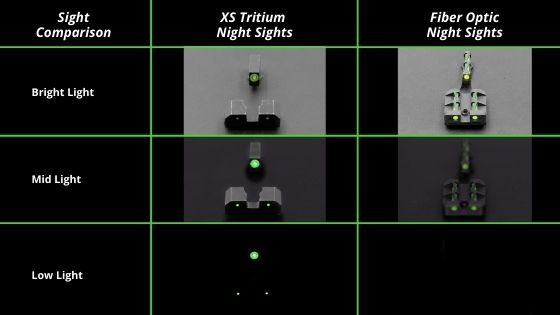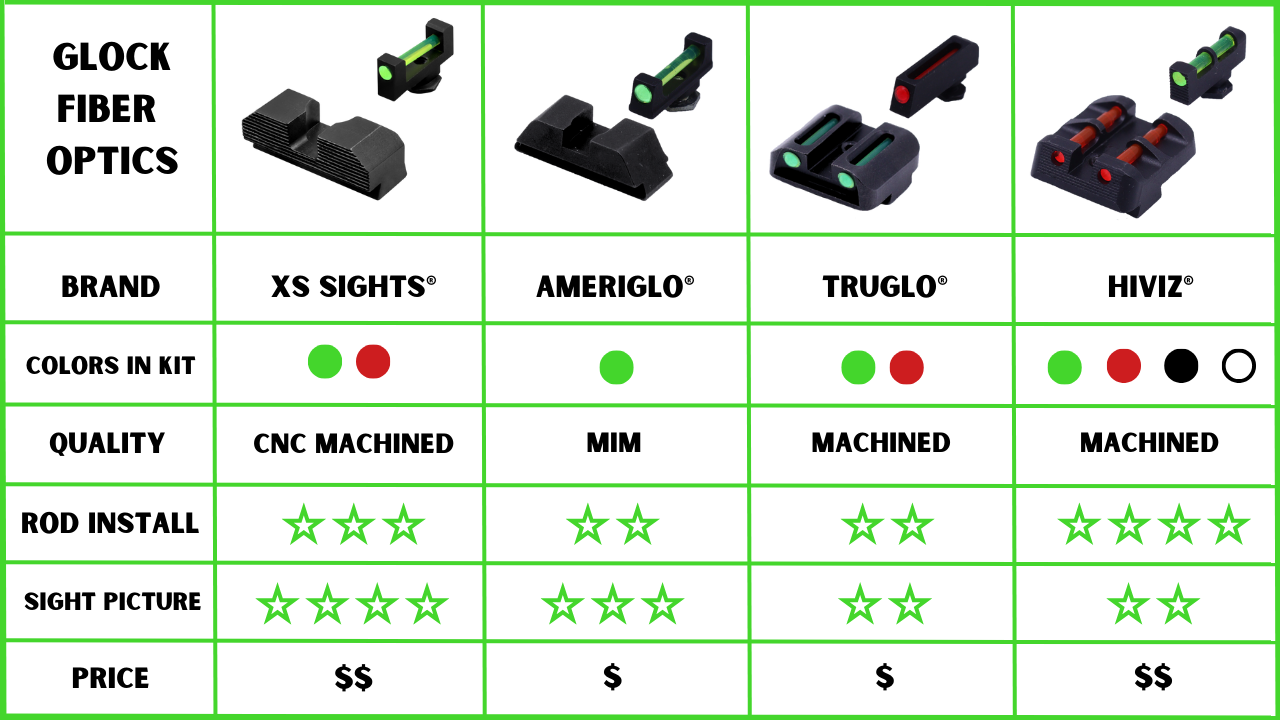Tritium Night Sights vs. Fiber Optic Sights
Posted by XS Sights on Apr 23rd 2021
When it comes to shooting accuracy and firearm performance, sights play a critical role. Upgrading your firearm's sights can make all the difference in the world. Two of the most popular sight types are Tritium and Fiber Optic. While both offer advantages, choosing between them can be a tough decision. Which one is better, and how do they really compare? In this post, we'll explore the differences between Tritium and Fiber Optic sights to help you choose the best one for your needs.
Tritium sights are a type of night sight that uses radioactive tritium gas in their construction. The gas is contained within small glass vials, which sit within the sight housing and emit a glowing light when exposed to darkness. Tritium sights do not require any external light source to be visible in low-light conditions, making them ideal for use in nighttime shooting scenarios.
Fiber optic sights are a type of day sight that uses a short length of fiber optic material within the sight's housing. The fiber optic material absorbs ambient light and channels it to the front sight post, creating a bright and illuminated aiming point. Fiber optic sights are best suited for bright daylight scenarios rather than low light or complete darkness.
Tritium night sights are commonly compared to fiber optic sights when shooters are making upgrade decisions on their pistols. Everything in life has a pro and con list; there is no magic bullet that provides the perfect solution. We at XS strive to drive the message that guns and accessories are purpose-driven tools. Tritium night sights are built for durability and visibility in low light. Fiber optic sights are built to be highly visible in bright light, making them an excellent option for sport shooting. Come with us as we go over the pros and cons of tritium vs fiber optic sights.

Tritium Pros —
Our tritium sights glow in low light, use high-contrast glow dots to provide high visibility in bright light, and are extremely durable. Our sights glow for over 10 years, have a 25K+ round service life, are drop safe, and survive aggressive cleaning agents that contain Acetone. The safety requirements for tritium are rigorous, and our sights are CNC machined for accuracy. CNC machined parts are made from good quality metal and are very durable.
Tritium Cons —
Tritium is expensive, translucent in bright light, and glow intensity dims over time (10 to 12 years). The sight designs need more steel to surround the circumference of the lamp for protection, making the sights taller and wider than conventional sights.
Fiber Optic Pros —
Fiber rods illuminate well in bright light, offer many diameter options and color options, have easy-to-change rods, and are low-cost. Fiber optic sight bodies do not have a lot of coverage because the walls of the rod need to be exposed to ambient light to provide a high-visibility glow in daylight. These qualities make the sight bodies low profile. They tend to be metal injection molded because of the simple design, which drives down the cost.
Fiber Optic Cons —
Fiber Optic Sights work only with bright light; even cloud cover can reduce the apparent brightness of the sight. The fiber rods are fragile, and they will not hold up to multiple drops or high round count shooting. Manufacturers try to solve the fragility issue by including a few inches of extra rod. The rods are easy to replace, but if the rod breaks while shooting, you have to switch to focusing solely on your sight blade. Fiber rods are not resistant to cleaning solutions. Acetone will bleach the rod, and the heat from ultrasonic cleaners can melt the rod.
Fiber rods glow brightly in bright light settings because the rod gathers light and funnels it to the rod endpoints. The longer the rod, the brighter the sight, but the fragility also increases. In low-light settings, the rod is no longer visible and does not glow.
Fiber Optic Brands
When comparing fiber optic sights for Glock pistols, enthusiasts have a variety of options, each with its own set of features and price points. XS Sights offers a kit that includes both green and red front sight color options and a blacked-out serrated rear sight. Notable for our CNC machined construction, guaranteeing both durability and ease in the installation process. The clear and rapid sight acquisition these sights provide makes them excellent for competitions, all for under $100. Amerigo opts for a straightforward approach with a green front sight color and a blacked-out rear, utilizing a Metal Injection Molded (MIM) sight body. While the rod is more challenging to replace compared to XS Sights, the sight picture is still decent, with the added benefit of being priced under $50. Truglo also provides a green rear sight and red front sight option to distinguish between the front and rear sights, featuring machined construction and an okay rod installation experience. Although the sight picture is tight, the price remains appealing at under $50. Hiviz broadens the color palette with green, red, and white front sight options and green, red, or black rear sight options, ensuring shooters can customize their sight picture to their preference. Similar to others, Hiviz uses machined construction for the body but stands out for the ease of installing or changing sights with the inclusion of their fiber-changing tool. They also have a tight sight picture and come in at a price point under $100. With many options to choose from it is helpful to weigh the pros and cons of each and know what your primary use for the gun will be. XS Sights new fiber optic sets are easy to see, fast to acquire, and offer precision for gaming! Click to shop Fiber Sights.
Common Misconceptions
A common misconception when comparing tritium night sights to fiber optic sights is, "If it's too dark to see my sights, then I need a flashlight to identify my target, and the ambient light will illuminate the fiber." Below are a few examples of flaws in that logic:
- Fiber loses its bright illumination quickly in decreasing light levels.
- In a defensive situation, your attention needs to be on the threat; hoping ambient light will illuminate the fiber rod when you need it is not the right mindset for that moment.
- In dark-light settings, your eyes have adjusted to the dark and can see quite well. Our eyes do not adapt to rapidly changing light levels quickly like the bright shock of a flashlight.
- Tritium sights are not an alternative solution to flashlights in a dark-light setting where you can't identify your target. They are meant to be used together. Proper low light tactics are meant to minimize your light exposure and not identify your position to the threat while still being able to index your front sight.

Tritium night sights are great for low-light and defensive shooting. The large footprint sight bodies make finding the front sight quick and easy. They are also continuously illuminated. Fiber optic sights are great for sport shooting; the small diameter rod allows for greater precision shooting, and the rod lights up like a light bulb when outside.
When selecting a sight, you must consider the shooting environment. If you're mostly shooting indoors or in low light conditions, tritium sights or night sights are definite must-haves. That's why military, police and tactical shooters prefer tritium sights. If you're hunting or shooting outdoors in bright daylight conditions, you might want to go for fiber optic sights. Remember, it's not only about your personal preference but something that can fit seamlessly in your shooting environment.
While we believe in our tools and tactics, we admit there are multiple tools in the toolbox that can accomplish the same goal; with the appropriately skilled person. Be sure that you have the right tool for the job. Knowing these pros and cons while considering your most frequent or anticipated shooting situation and the intended use of the particular gun setup will help you to make an informed decision about which tools are right for you.
About the Author
XS Sights manufactures the fastest sights in any light. From concept and design to creation, XS utilizes tritium, photoluminescent materials, and 25+ years of sight manufacturing expertise to create highly visible and durable sights for personal defense, military, and hunting applications. Proudly made in U.S.A.


